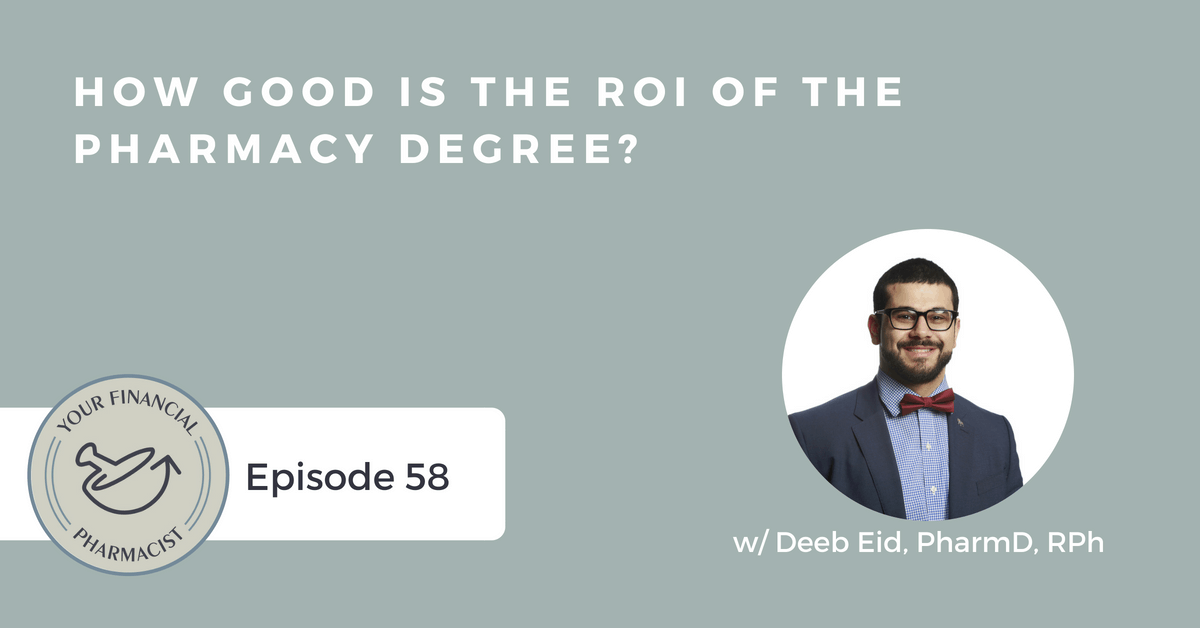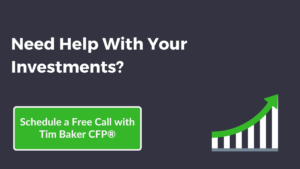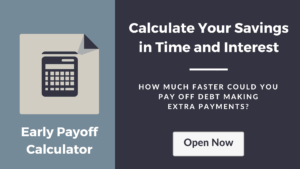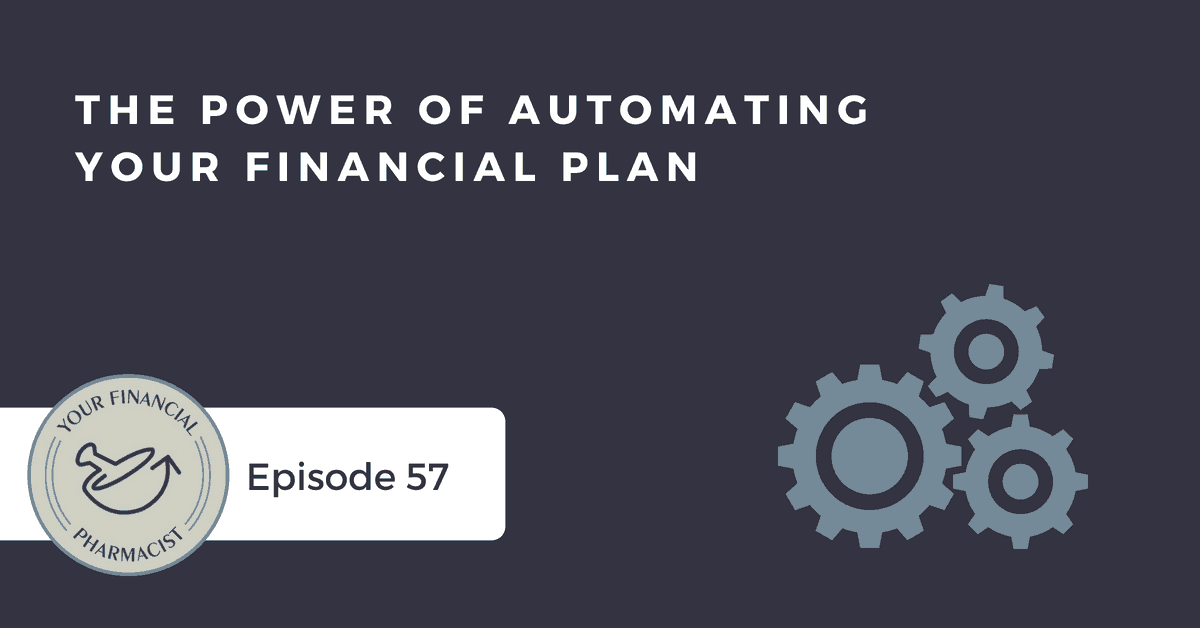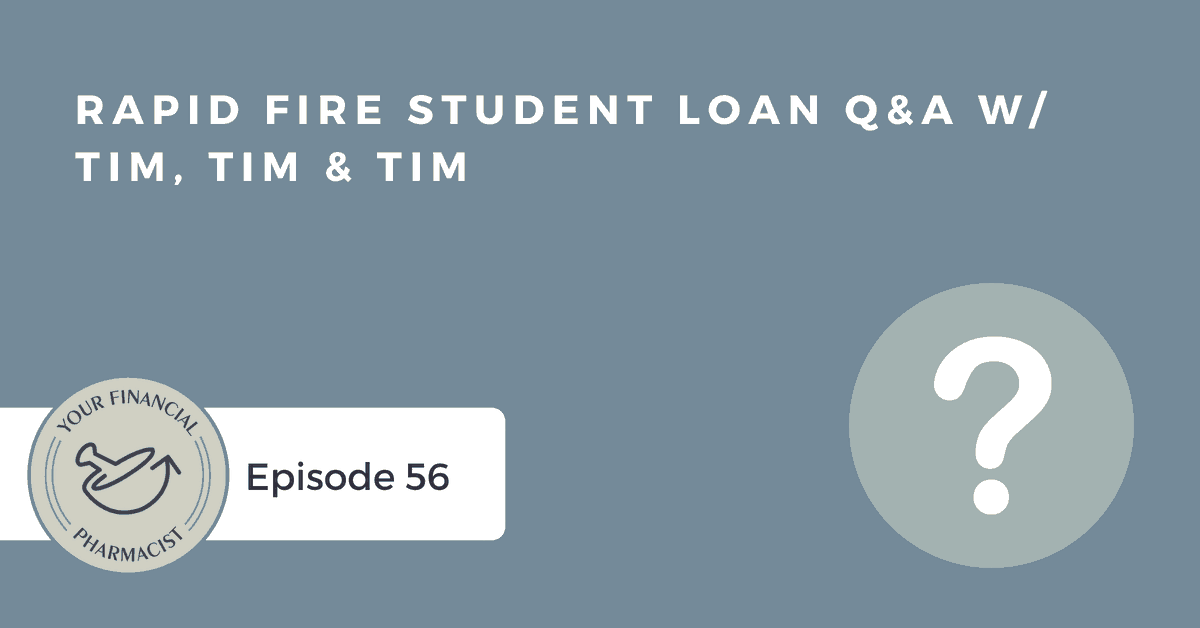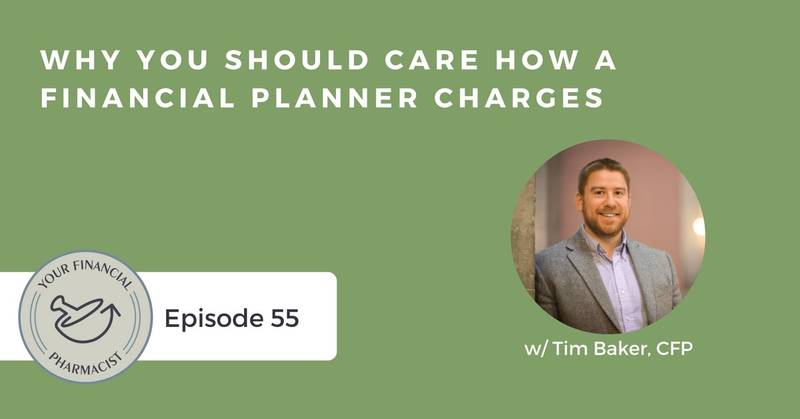On Episode 58 of the Your Financial Pharmacist Podcast, YFP Founder Tim Ulbrich interviews pharmacy thought leader Deeb Eid, host of the Pharmacy Universe Podcast, about how rising student debt loads and a tightening job market are impacting the return on investment of the pharmacy degree.
Deeb Eid, PharmD started his pharmacy journey as a pharmacy technician learning the building blocks of what both efficient and non-efficient workflow operations could look like. He gained a deep appreciation for the role and potential of the pharmacy technician and continued forward with Bachelors and Doctor of Pharmacy degrees from The University of Toledo College of Pharmacy & Pharmaceutical Sciences in Ohio. His talents took him to Washington D.C. to become the inaugural Executive Resident in Association Management & Leadership at the Pharmacy Technician Certification Board. While traveling the country, he was able to present, meet with, and discuss the challenging and evolving atmosphere within pharmacy with a variety of stakeholders. He now serves as an Assistant Professor and Experiential Coordinator at Ferris State College of Pharmacy in Grand Rapids, MI working to mentor and inspire students while creating new avenues and opportunities. Deeb is the Founder and Content Strategist of Pharmacy Universe which is a social platform whose vision is to socially educate and engage the world about #Pharmacy.
Mentioned on the Show
- Script Financial
- Pharmacy Universe Podcast
- American Association of Colleges of Pharmacy (AACP)
- American Pharmacists Association (APhA)
- Pharmacy Universe Episode 004: Finance and Education (Your Financial Pharmacist, Dr. Tim Ulbrich)
- Pharmacy Technician Certification Board (PTCB)
- YFP Episode 004: The Landscapes of Student Loans In Pharmacy Education with Dr. Joey Mattingly
- AACP Graduating Student Survey
- AACP Enrollment
- AACP Degrees Conferred
- Pharmacy Manpower Index (Pharmacist Demand Indicator)
- Bureau of Labor Statistics (Pharmacist)
- YFP Episode 053: One Pharmacist’s Journey From Financial Ignorance to Financial Independence with Tony Guerra, PharmD
- Munger MA, Gordon E, Hartman J, et al. Community pharmacists’ occupational satisfaction and stress: A profession in jeopardy? J Am Pharm Assoc. 2013; 53(3): 282-96.2013
- Ohio Pharmacists Association (OPA)
- Art of Manliness Podcast
- How I Built This Podcast
- Impact Theory with Tom Bilyeu
- The Third Door: The Wild Quest to Uncover How the World’s Most Successful People Launched Their Careers by Alex Banayan
Episode Transcript
Tim Ulbrich: Deeb, welcome to the Your Financial Pharmacist podcast. Appreciate you joining us.
Deeb Eid: Yeah, thanks, Tim. I really appreciate you having me on.
Tim Ulbrich: So you’re in Boston for the American Association of Colleges of Pharmacy meeting, AACP. So how’s Boston and how’s that meeting going?
Deeb Eid: Well, Boston’s a really cool place for anybody who hasn’t been there. I highly recommend coming and visiting. Lots of things to do, lots of things to see. And the meeting’s going awesome so far. I think there’s a lot to learn. It’s a little bit different for me, I’m used to the APhA crowd. But definitely meeting some new people, gaining some insight about what’s going on in pharmacy education, and also reconnecting with a couple old friends.
Tim Ulbrich: I’m so bummed I couldn’t go. I’ve been to that meeting several times. Great networking, great programming. I do have to say, as a Buffalo Bills fan, I’m a Patriots hater, so I’m not sad about that point about not being in Boston. I’m sure there’s lots of Patriots, Red Sox fans around. And what I want to do on this episode is, to be honest, I think we have a long overdue discussion about what’s the Return on Investment of the pharmacy degree? And last week on your show, the Pharmacy Universe podcast, which we’ll link to in the show notes, Episode 004, you and I had a discussion related to personal finance and the future, we talked about debt loads and what this means for new practitioners, but we did get off on a little bit of a tangent , which was good, about some of the evolutions of the profession and where we’re heading. And disclaimer for listeners before we jump into the weeds on the discussion is that while we’re going to make a case that the Return on Investment of the degree is down in terms of where it has been, we are certainly not dismissing the fact that pharmacists make a good income, make a good living. And the reality is as individuals, a pharmacist’s income is still well above the median household income in the U.S. So it’s all relative, but we are certainly talking here about the shifts and the changing market that we’re seeing over the last 7-10 years or so. So three parts of this show that we’re going to walk through. Part One, we’re going to talk about the impact of high debt loads and a tightening job market. Part Two, Deeb and I are going to talk about how doom and gloom really is the situation? Are we overplaying it? And in Part Three, we’re going to talk about the action because I think we have a lot of people getting fired up, a lot of people complaining, but what are we actually going to do about this going forward? So Deeb, before we jump into the national trends and start this discussion on the Return on Investment of the pharmacy degree, as a new practitioner yourself, tell us a little bit about your career story, your journey and maybe even how student loan debt has played its part in your own journey.
Deeb Eid: Yeah, Tim. So a little bit about my background and my story is I went to the University of Toledo in Ohio. Go Rockets!
Tim Ulbrich: Go Rockets, yeah.
Deeb Eid: And during my time there, I started out working in a pharmacy as a pharmacy technician pretty early on, basically right out of high school, started out that summer and started to really gain an appreciation for what happens in workflow of a community pharmacy. And it’s kind of like almost like an art, you know? You go and you work at different stores and you see things run smoothly, and then you go to a different store and you see things on a particular day, maybe run not so smoothly. And so through that process, I started gaining appreciation for the role of the pharmacy technician. Obviously went on, completed my PharmD and had a really interesting and awesome opportunity to complete an executive residency out in Washington, D.C. with the Pharmacy Technician Certification Board. And so through that experience, I was able to basically travel across the country, meet different people, see what’s going on within the profession and kind of like what you’re saying, meet new practitioners, meet people who have been in the profession for 20-40 years and hear their stories and hear what their thoughts are. And I think personal finance is actually a topic that comes up really no matter what just because of, yeah, what’s happening with student loan debt and asking people, oh, I can’t believe — and they’ll tell you, I can’t believe how much people are paying for school nowadays compared to back when I went to pharmacy school. And so my story relating to student loan debt is — and I’m not here to turn any of your listeners off — but to be honest with you, I was extremely fortunate, and I actually had my schooling — my father really actually helped pay for most of my schooling.
Tim Ulbrich: Awesome.
Deeb Eid: So I never really thought about student loan debt throughout my schooling. It wasn’t something that was a stressor to me. But what I did learn through the process is now reflecting back, how was that possible? How was my father able to in his personal life be able to support me in that way? And the other thing I think I learned was that everyone around me, this was one of the focuses of themselves, and so I needed to learn about it because, you know, people talk about it, so I want to be included in the conversation. But more recently, my significant other Kristen is also dealing with a situation now after she just graduated of looking at student loan debt. And so it’s a topic that even though I don’t have personal experience paying off student loan debts or worrying about it, it’s still something that I feel is extremely important because a bunch of people around me have it, and I want to be able to and need to be able to explain and help them and students, now that I’m an educator.
Tim Ulbrich: Yeah, and I think one of the things, just building off of what you said there, is you know, while obviously you had a very fortunate situation, if we look at the data nationally, 90% of all graduates have some student loan debt with the average amount being just now over $160,000, although we’re waiting for the new data here in 2018. And what I’ve heard, and I’m guessing you’ve heard from colleagues and peers and even those you’ve essentially interacted with your podcast at Pharmacy Universe, is that this is such a big stressor and weight on their back that one of my concerns here as we talk about the ROI of the pharmacy degree is we are in desperate need of innovation in pharmacy practice. And sometimes with innovation comes risk-taking, comes entrepreneurship and trying to build some new things. And one of my concerns, and one of the things we’re trying to tackle at Your Financial Pharmacist, is that you have this massive gorilla on your back that is maybe making you risk-averse, is stressing you out, obviously, that has an impact I think profession-wide in terms of what we can do in regards to being innovative. And so I would point listeners all the way back to Episode 004 where we interviewed Dr. Joey Mattingly from the University of Maryland, another thought leader, in my opinion, and we talked about very analytically what has been the impact of student loan debt in terms of new practitioners. And we got very granular and got very specific with numbers in terms of how it’s impacting graduates and how that’s changed. So let me paint a quick picture, and I’m going to dig into the weeds here a little bit on some numbers, so for those listeners, don’t tune me out here because I think the data does not lie. And we have to understand that the situation we are in right now is not a normal situation relative to, say, five or 10 years ago in terms of where we are as a profession. So I’m going to give some data here about debt loads, salary data, and then also we’ll talk a little bit about what’s happening to the job market. So first on debt loads, very simply, 2010, the median debt load was $100,000. 2017, it was about $160,000. So we had almost a 60% increase in seven years. And so I often hear people say, well, nationally, debt loads have gone up x%. True, but if you look at pharmacy education among some other health professions, that has outpaced the national average in a very significant way. Well, the other part to look at is if debt loads have gone up, have salaries increased proportionally? Because if they have, then we can make an argument that man, this really stinks that debt loads have gone up, but salaries are taking care of it. And the answer to that is they are not. So if we look at median salary for a pharmacist in 2010, it’s about $111,000. In 2017, it’s about $124,000. So I’m always looking at what’s the debt-to-income ratio of a pharmacist? And in 2010, that debt-to-income ratio was .9. In 2017, it was 1.28. So what’s interesting is if you look at pharmacists’ salaries alone, they are not keeping up with inflation over that time period. So even if we were to remove student loan debt and interest rates and the reality that some people are not in part-time work positions, those incomes are not keeping up with inflation alone. Of course, when you add in all these other factors, that situation becomes worse. So now we ask the question, Well, if we have people that are graduating with more student loan debt, salaries are not increasing proportionally, well, how much is their likelihood to get a job? What’s the job market look like? And there, we look to the Bureau of Labor Statistics. And what we see that as of 2016, there was just over 312,000 jobs in the pharmacy profession. And now, here is the statistic that is alarming to me, that the Bureau of Labor Statistics is projecting that over a 10-year period, 2016-2026, they’re projecting 17,400 jobs that would be increased during that 10-year period. But in 2017 alone, we had approximately 15,000 pharmacy graduates. So let me say that again. Over a 10-year period, they’re projecting just over 17,000 new jobs. But in one year alone, 2017, we had approximately 15,000 new pharmacists enter the market. So something has to give. Now, some people look at that and say, well yeah, of course people are going to retire, other things are going to change, but obviously that’s not going to make up for that difference. So there, we need to begin the conversation about what is the challenges, what are the challenges with the situation and what can we start to do about it? So in summary, we have higher debt loads, we have fewer availability of jobs, we have more graduates that are coming into the market. So Deeb, my question to you is from your perspective, as somebody who I look to as an innovator and a thought leader, what are the risks and challenges that you see with graduates that are coming out with rising debt loads and relatively speaking, a stagnant job market? What are your thoughts?
Deeb Eid: So I think first of all, some of the numbers that you provided there, again, are pretty interesting. When I take a look at the statistics and I see, like you said, the Bureau of Labor Statistics projecting that many jobs over 10 years. And you and I very well know that there’s a lot of people who are graduating from pharmacy school each year. I think some of the risks and challenges with graduates coming out having these rising debt loads is — you’re right. That’s the tough part is when you come out of school and you have this thousand-pound gorilla of student debt on your back, and you’re trying to figure out where to start off in life, right? So you have a lot of different things going on. You might be moving for a job or a position or a residency. This could be your first car buying opportunity, this could be your first home buying opportunity. There’s a lot of things that happen in those first couple years as a student who graduates, becomes a pharmacist and now looks at your paycheck and thinks, oh man, I have all this money now. And so that’s where I think it’s challenging because people are going to be stuck, to an extent, where you might get a job, you might not be happy with the job that you have or you might not be satisfied. But you know that you need that job in order to be able to pay for that car, pay for that home, pay for those student loans. And so that’s I think part of the challenge is yes, there’s going to be people retiring, so there’s going to be jobs opening up, but what I really think is interesting — and maybe we can talk about this is the opportunities that could come from people focusing their time on different areas and trying to think outside the box of what they can do to, you know, again, build a brand, build a market and figure out ways that pharmacy can be involved in healthcare in ways that are nontraditional from what we’re currently doing.
Tim Ulbrich: Absolutely. It makes me think back to Episode 053, we interviewed Tony Guerra from the Pharmacy Leaders podcast who his Episode 001, Pharmacist’s Journey from Financial Ignorance to Financial Independence, one of his suggestions that stuck with me and will stick me I think forever is this idea of as a new graduate, he took what he calls Entrepreneurial 8. So right off the bat, he took 32 hours a week — he actually tried to work 24, but they wouldn’t let him — 32 hours a week, and he said, you know, 8 hours a week, I’m going to begin to think about some of the things that I’m passionate about, pharmacy practice and how I can be entrepreneurial. Now, from the financial perspective, that to me is a brilliant idea and I think it’s great for the profession as well. Obviously, we’ll be advancing thoughts and ideas, but also, it requires somebody to be able to right off the bat say, OK, I’m not going to live up to my full income. And obviously, it starts to give you options and flexibility in the event that things change along the way. Now, student loans, if you’ve got $200,000 of student loan debt, is it going to be easy to say, ‘I’m going to take 32 hours instead of 40.’ And is that the best decision in the moment? You know, maybe yes, maybe no, depending on your personal situation. And I think that’s one of the biggest fears, if you will, that I have right now is that there’s this mentality that I’m feeling and that I felt as a new graduate of maybe you’re in your mid-20s, maybe you’re even a little bit older as a student, you’ve got over a six-figure job that’s right there, sign the paper. It’s comfortable right off the bat. Does it restrict you, though? And is it restricting what we’re able to do and evolve as a profession? And I think the reality of that business model is it’s gotten us stuck into a place of where we’re at right now. And there’s not necessarily as much room and opportunity for innovation, growth and risk-taking. And Deeb, I don’t know what you’re seeing — I know one of the things I’m hearing among our graduate is there’s this feeling, obviously in some sectors of work moreso than others, but there seems to be this feeling of I’m only a couple years out, what I had imagined this could be, it isn’t what I thought it could be. Now I’m looking up and I’ve got 35, 40 years left of work history, and I feel stuck. I mean, is that something that you’re hearing? What do you perceive to be the implications of that in terms of somebody so early in their career feeling like they’re stuck?
Deeb Eid: So I’ll tell you from a personal standpoint, I worked during my school, so while I was in pharmacy school, so I worked for about six years, so throughout the entire six years at Toledo, I was working. And I worked in a couple different — I worked in a couple different pharmacies. And to be honest with you, that statement that you made, that feeling of not really ‘I feel stuck,’ but it’s more of, ‘This isn’t really what I think I expected,’ or, ‘This isn’t really aligned with what I thought I would be doing,’ that was honestly one of the feelings that I had throughout those towards the end of those six years was I know what I’m learning in school, I understand what could be, but then there’s things that happen at work or there’s responsibilities that I’m doing at work that just doesn’t feel like I’m living up to the potential or you know, I could be doing so much more for my patients. I just am not able to or my company maybe doesn’t allow me to or the laws or regulations don’t allow me to do these things. And so that’s what I think for me, from a personal aspect, that’s where I felt I needed to do something a little bit different. Hence, why I went out and did my residency in an area that was a little nontraditional. But yeah, I mean, I talk to some of my former classmates and a couple other people out there who are newer into the profession, and it is something to think about. I’ve heard a few times here and there that, well, you know, you kind of get into this — it’s almost like a rhythm. You learned all these different things, there’s all this potential, and then it’s like your dreams and hopes are shot down.
Tim Ulbrich: Absolutely.
Deeb Eid: It’s kind of an interesting phenomena.
Tim Ulbrich: Well, and I think we know — for me, I’m very passionate about career development. It’s what I do a lot here at the university. And the reason is exactly what you’re saying. I mean, what we know and what I’ve seen in our alumni and seen in my own life is that if you’re challenged in the work environment, if you’re given autonomy, if you’re allowed to be creative in the way you think, if you’re allowed to be entrepreneurial even within an organization, that feeling of satisfaction that comes from that trickles over to many other areas of life, right? You walk home more confidently, and it can have an impact on relationships and other areas. And so one of the things that I’m passionate about, specifically for the financial piece, is trying to help people manage this financial component so that they can maybe look at an alternative job path. Maybe they can go back for additional training, back for additional schooling. Maybe they can start their own business and take a few more risks. And one other thing that really stuck out to me as I was preparing for this show — and you’re probably familiar with the 2013 study that was published in the Journal of American Pharmacists Association, JAPhA, that we’ll link to in the show notes. It was a study done by Munger, et al, which has had a lot of attention and debate. And essentially, they studied, take-home point is they studied over 300 community independent pharmacists, and their conclusion was that there was high amounts of dissatisfaction. Specifically, more than 50% of those surveyed stating that they were considering quitting their job. And I think that’s such an important point. And whether we want to debate is that representative, is that not, we know that and we have a pulse on that there is that feeling out there. And if we, as a profession, are going to move forward and be innovative and be forward-thinking and rock the boat and think about the way pharmacy’s been done, and think in the futuristic type of way and not look back at how it’s always been done, we’ve got to address this feeling that’s out there, and we cannot ignore that it’s out there. And I think one of the risks, to wrap up this first part here, one of the risks that I see — and the numbers support this — is we have a very significant decline in applicants into PharmD programs across the country. And that should be getting all of us fired up. So let me give you some data here. 2010-2011, we had approximately 107,000 applications into pharmacy school. 2016-2017, that number went down to 73,000 in that time period. All the while, the number of schools increased in a dramatic way. So in theory, we should have more applications. So we have more graduates coming out with less applications coming in. So that’s the transition then into the second part, and really what I want to discuss here for a few minutes is how doom and gloom is this situation? You know, we could stop here and say, the sky is falling. Are we over playing it? Is that reality? And to me, Deeb, it feels like that we’re at risk, as a profession, of being stagnant in the way that we do business when the market is clearly telling us the status quo is not OK. And when I say the market is telling us, I’m referring to the number of applications into pharmacy school, that’s an indicator of interest in the profession as well as what we’re seeing in the evolution of the profession. Most notably, we’ve talked recently on your podcast about the Amazon buyout of PillPack. You know, it feels to me that we’re at risk of becoming the Blockbuster in the Netflix world, right? So my question to you is how doom and gloom is the situation? Is it worth sounding the alarms? Are we too late? Or is this a trend that we can really start to reverse? What are your thoughts?
Deeb Eid: So a couple things come to mind when I think about the situation. No. 1 being what I try to do when I, from a big picture standpoint, when I look at the situation, I try to actually look outside of the profession of pharmacy. So what’s going on? What are the trends within consumer buying? What are people looking for? What is the average person on a day-to-day basis, what are they expecting out of the businesses, out of the services that they are getting from other places? So if you look at businesses like Netflix, like Amazon, like Uber, some of these ones that really, really, have come out of nowhere in the past few years but have really just become leaders across the board. So some of the things that I think about is you know, if you take a look at those organizations, what are three things that they focus on that we, as a profession of pharmacy, can learn from? And I think three things that I see is when it comes to the person on the other side of their services, No. 1 is that they help save people time. OK? So time is something that I believe any person out there would put a major premium on. If you can save somebody time in their life, that means that that’s time that they have to reinvest in something that they enjoy doing. So I think that’s a huge thing that a lot of these companies have in common. No. 2 is convenience. They’re making it more convenient for the person on the other side, right? So you want something from the store? You don’t need to go to the store. You can order it on Amazon, and it’s there the same day or the next day. You want to watch a new series? Turn on Netflix. There you go, you can watch the entire series. You don’t even have to move from the couch anymore.
Tim Ulbrich: Right. And now it’s predicting what you want to watch, right? It’s amazing.
Deeb Eid: Exactly, it’s telling you different things based on your shows. You know, you want to get somewhere quickly and again, know where you’re going and be convenient and safe, take Uber. And I know people will say, oh, there’s some stories with Uber that people have gotten hurt, but far and in between. But again, it’s that convenience. And then the third thing — so you know, you have time, you have convenience. And the third thing that I believe these places are doing is they are just, they’re listening to the consumer. They’re listening to their customers as to what they are looking for. And that’s why they keep improving their models. And so I think from a pharmacy standpoint, you know, for doom and gloom. Is the situation getting worse? Is it getting better? I think that in pharmacy, like you said, people are coming out, they have a lot of student loan debt, that’s limiting innovation, that’s limiting opportunities for people to be innovative. Sometimes, they’re getting into positions where they’re not going to be able to come in right off the bat and you know, kind of think outside the box unless they really spend time and effort outside of their jobs doing it. You have less people applying to pharmacy schools, you have a decent amount of graduates. And so I don’t want to say that we’re doomed as a profession, but I think that what we need to do is we need to start looking at the models that we’re utilizing and figure out where can we start to focus on those types of areas because the future consumer and the current consumer are somewhat different, right?
Tim Ulbrich: Yes.
Deeb Eid: So I think a lot of the people in today’s world in the future are going to expect that you can pick up your phone, hit a button, and boom, there’s a pharmacist on the screen. I want to have a conversation with somebody, I have questions about my medication, boom. A future consumer is probably going to expect they’re in their kitchen, and they’re about to have dinner, about to sit down for dinner. They can say, ‘Hey, Alexa, tell me about my medication. Am I able to take it with this type of food that I’m about to be eating? Is there any interaction?’ These are the things that are being built into society that I think the future consumer is going to expect, and that’s where I see the opportunity for, you know, people within pharmacy and graduates to be involved. It’s just not going to be in the traditional what you think of now where you’re going to get a degree, you graduate, you work in a pharmacy. I mean, those things are still going to be available, but I think that’s where the jobs and the opportunities are going to be is we’re going to have to start creating these opportunities so that we can continue to reach our patients in a way that’s convenient, that saves them time and that’s still quality.
Tim Ulbrich: Yeah, absolutely. And I think there’s so many good nuggets that you had there. I mean, to me, one of the things that I’m often thinking about that you highlighted there is we are at a point, I think, I believe, that we have to think about reinventing ourselves as a profession and the role of the pharmacist. We know the value, we have the data to support it, but we need to blow up preconceived notions about exactly how pharmacists have to operate and how pharmacy is done in every single setting that we operate. And I think one of the great advantages of these moments like we’re in as a profession is that with any moment like this comes unbelievable opportunity for innovation, entrepreneurship and growth. And as I used Blockbuster as a reference, Family Video is still around. I’m still trying to figure that out. I don’t understand that. But you know, with those models, there’s an opportunity to either evolve or not evolve. And so I think we can look at it one way and throw up our hands and say, ‘Ugh, this is terrible. We need to hold onto the way that pharmacy’s done, and we’re going to hold that out regardless of the things you mentioned, that time, convenience, understanding what the future consumer wants,’ or we can get together, have the uncomfortable, difficult conversations and say, ‘Let’s throw out the way it’s always been done at least in thought. Let’s brainstorm about alternative ways that it can be done. And let’s think about it from the consumer standpoint and also think about where technology, automation and other things are going.’ And I think you used some great examples there, even with Alexa is one example but just to get us thinking in a different way. So let’s move now to the call to action. What are we going to do about this? And I know we talked briefly about this in that last section, but we’ve painted a picture of the current reality we’re facing as a profession. And now the question is, so what are we going to do? What steps should we be taking? And what practical things can our listeners to begin to reverse this trend? What do you think, Deeb?
Deeb Eid: Yeah, so I think the very first thing that is, you know, low hanging fruit — and I would say this is probably something that anybody who comes across us, anyone who’s listening, no matter your situation, I think that if you can take at least one step in this direction, you’ll be definitely doing yourself a favor. Just learn about personal finance. Take advantage of, you know, things that you guys are doing here at Your Financial Pharmacist. Read a few different articles about it, learn about student loans if that’s something that you’re dealing with. Just learn about finance in general because I can’t tell you how simple it is to — you know, it’s just like learning therapeutics, it’s just like learning pharmacology. And it sounds very, you know, overwhelming, it sounds like, man, like I don’t speak this language, but it’s the same thing, right? You just have to put in time. It takes a little bit of effort, but if you do it step-by-step and utilize I think the community that you guys are building with Your Financial Pharmacist, that’s another awesome thing is you have other people out there who are going through the same things that you are and you can learn from them and you can ask questions and you can interact with them. And so that’s I think step No. 1 is really just taking it on your own onus to learn about personal finance because that, I believe, is going to save you a lot of stress in your future or wherever you’re at in your career. So I think that’s kind of one step that I see. The second step is having those conversations, like you said, those difficult conversations and coming up with these creative ways but really trying to, again, figure out in your current workplace, in your current situation, in your current life, what is something, what is one thing, what is one thing that you could be doing that could be challenging or helping to, again, look outside of pharmacy and figure out what that future person, what that future consumer might be expecting. What is one thing that you might be able to start working on that would be able to help the profession of pharmacy. So you know, that could be starting up a blog about your thoughts and your experiences and you know, how things might be different at your workplace or things that you’ve seen with your patient care or wherever you work. That could be starting up a podcast, you know, just like we’re doing here and just like I’ve done over at Pharmacy Universe and just talking to people and having the conversation, getting the word out there. That could be writing a book. I know that sounds very challenging, but you know, there’s a lot of great books out there that I’ve seen, and I think there’s not enough books out there about these topics that we’re talking about today, about how pharmacy is evolving and kind of what different opportunities that there could be out there. So those are kind of three areas that I could see. I believe personal finance is a big one, thinking about building a personal brand is probably the second one, and then the third one is connecting with the community and just figuring out how to disseminate some of your ideas and thoughts that you have — or at least learning from others that have those ideas.
Tim Ulbrich: Great stuff. And if I could add a few things to that list that are on top of my mind. You know, one for me is you’ve got to be a part of the conversation. So whether that means being active in your local, state, national organizations, you know, on this podcast, we’ve done a lot of work with the American Pharmacists Association. It could be your state pharmacy association, your local group, because to be a part of the change is different than just complaining about it, right? So pay the membership dues, get involved, be at the table. And second to that comes being a part of the change when it comes to legislation and advocacy. So if you want to see a change, I’ve seen this firsthand with the work with Ohio Pharmacists Association, it’s not as difficult or overwhelming as it may appear from the outside looking in. So engage in those areas. And then Deeb, one of the last things I want to mention here is I’ve been trying to do more self-development outside of the pharmacy space. So I felt like I kind of fell into this rut of, you know, I’m always learning from pharmacy literature, pharmacy conferences, all great, but there’s so much to learn outside of the pharmacy space, even outside of the health profession. So I’ve been listening to some podcasts and reading some books lately, watching some TED Talks. One of the things that’s catching my attention recently is some more U.S. History type of stuff. I was just listening to a podcast on FDR to Harry Truman and that evolution and struggles and challenges, one back to the American Revolution. And I think getting to think in a different way to say, here were leaders and individuals and people and times in our history that had very challenging points where they had to pivot and make a decision, and they had to rally people around them to achieve a shared vision. And so we will link to some of those in the show notes, but just getting out there and saying, I’m going to do one thing, like you mentioned. Maybe it’s getting out there and getting inspired from some TED Talks or books or podcasts or joining an organization and becoming more active. I think there’s lots that we all can do collectively as a group and a community to move forward. So what I want to do is end on a few rapid-fire, Q&A questions for you while I have you here. So I’m going to ask you questions, quick answers, and we’ll move through these one-by-one. So first question is, the trend in pharmacy applications, which is currently down, will continue over the next five years. True or false?
Deeb Eid: I think it’s true.
Tim Ulbrich: One piece of advice you’d have to a prospective pharmacy student in light of today’s conversation?
Deeb Eid: Learn about personal finance as much as you can.
Tim Ulbrich: Awesome. And finally, what is one piece of advice you would have to current students that are worried about the job market in terms of getting full-time work and the rising debt loads that they see?
Deeb Eid: I would say work on building your personal brand and make sure that you are utilizing your time so that you are one of the top candidates when you graduate and that you have options.
Tim Ulbrich: Great stuff. Deeb, thank you so much for coming on the podcast today. And for our listeners, we’ll link to the show notes, but if you’re not yet familiar with the work he’s doing over at the Pharmacy Universe, check it out. I’ve listened to the episodes you’ve published so far. I love the telehealth components, getting us to think different legislatively, trying to push the envelope, so thank you for the work that you’re doing over there and very much appreciate you taking the time to come on today’s show.
Deeb Eid: I appreciate it, Tim. And can I mention one thing? Because you had mentioned a couple of the different avenues of books and podcasts and that before I go?
Tim Ulbrich: Yeah, please. Please.
Deeb Eid: So there’s a book that I recently picked up — and if you’re not familiar, check out the YouTube channel, it’s called Impact Theory by Tom Bilyeu. It has some awesome interviews on there that really challenge you to think outside the box. So one of the interviews that I was watching had this particular person on here, and he wrote a book. And I actually just picked up the book here in Boston, but I’m going to recommend it. It’s called “The Third Door,” and it’s by Alex Banayan. And so basically, it’s this guy’s story about — I’ll give you a very quick summary. He says that there’s really three ways, that life is like a nightclub. There’s three ways in. There’s the first door, which is the main entrance, that’s where 99% of the people wait, hoping to get in line. They’re hoping to get into the club. There’s the second door, which is the VIP entrance. That’s where billionaires and celebrities get in. But then the one that no one tells you about, and that’s the third door. It’s where you have to jump out of the line, run down the alley, bang on the door 100 times, crack the window open, sneak through the kitchen. But he says that there’s always another way in and to be always looking for that way in. So I think that that kind of goes along with the theme that we’re talking about today.
Tim Ulbrich: Yeah, we definitely need a third door right now and people knocking on that door, so thank you for sharing. And I have a problem that when I hear of a book recommendation, literally within five minutes, I have to buy it. So I will be doing that right now and look forward to reading that on a vacation coming up in a couple weeks. So Deeb, again, thank you so much. And to our listeners, as always, thank you so much for joining us. Looking forward to joining you again next week.
Join the YFP Community!
Recent Posts
[pt_view id=”f651872qnv”]

